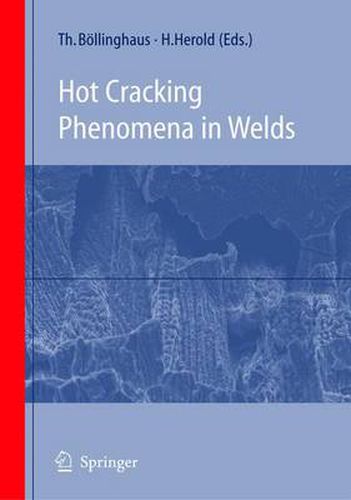Readings Newsletter
Become a Readings Member to make your shopping experience even easier.
Sign in or sign up for free!
You’re not far away from qualifying for FREE standard shipping within Australia
You’ve qualified for FREE standard shipping within Australia
The cart is loading…






This title is printed to order. This book may have been self-published. If so, we cannot guarantee the quality of the content. In the main most books will have gone through the editing process however some may not. We therefore suggest that you be aware of this before ordering this book. If in doubt check either the author or publisher’s details as we are unable to accept any returns unless they are faulty. Please contact us if you have any questions.
Although the avoidance of hot cracking still represents a major topic in modern fabrication welding components, the phenomena have not yet been fully understood. Through the 20 individual contributions from experts all over the world the present state of knowledge about hot cracking during welding is defined, and the subject is approached from four different viewpoints. The first chapter provides an overview of the various hot cracking phenomena. Different mechanisms of solidification cracking proposed in the past decades are summarized and new insight is particularly given into the mechanism of ductility dip cracking. The effects of different alloying elements on the hot cracking resistance of various materials are shown in the second chapter and, as a special metallurgical effect, the initiation of stress corrosion cracking at hot cracks has been highlighted. The third chapter outlines how numerical analyses and other modelling techniques can be utilized to describe hot cracking phenomena and how such results might contribute to the explanation of the mechanisms. Various hot cracking test procedures are presented in the final chapter with a special emphasis on standardization. For the engineering and natural scientists in research and development the book provides both, new insight and a comprehensive overview of hot cracking phenomena in welds. The contributions additionally give numerous individual solutions and helpful advice for international welding engineers to avoid hot cracking in practice. Furthermore, it represents a very helpful tool for upper level metallurgical and mechanical engineering students.
$9.00 standard shipping within Australia
FREE standard shipping within Australia for orders over $100.00
Express & International shipping calculated at checkout
This title is printed to order. This book may have been self-published. If so, we cannot guarantee the quality of the content. In the main most books will have gone through the editing process however some may not. We therefore suggest that you be aware of this before ordering this book. If in doubt check either the author or publisher’s details as we are unable to accept any returns unless they are faulty. Please contact us if you have any questions.
Although the avoidance of hot cracking still represents a major topic in modern fabrication welding components, the phenomena have not yet been fully understood. Through the 20 individual contributions from experts all over the world the present state of knowledge about hot cracking during welding is defined, and the subject is approached from four different viewpoints. The first chapter provides an overview of the various hot cracking phenomena. Different mechanisms of solidification cracking proposed in the past decades are summarized and new insight is particularly given into the mechanism of ductility dip cracking. The effects of different alloying elements on the hot cracking resistance of various materials are shown in the second chapter and, as a special metallurgical effect, the initiation of stress corrosion cracking at hot cracks has been highlighted. The third chapter outlines how numerical analyses and other modelling techniques can be utilized to describe hot cracking phenomena and how such results might contribute to the explanation of the mechanisms. Various hot cracking test procedures are presented in the final chapter with a special emphasis on standardization. For the engineering and natural scientists in research and development the book provides both, new insight and a comprehensive overview of hot cracking phenomena in welds. The contributions additionally give numerous individual solutions and helpful advice for international welding engineers to avoid hot cracking in practice. Furthermore, it represents a very helpful tool for upper level metallurgical and mechanical engineering students.